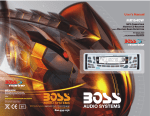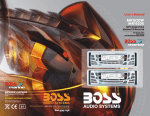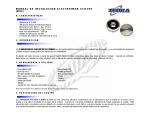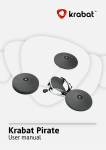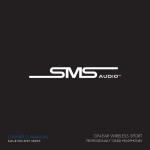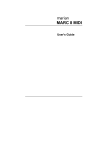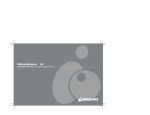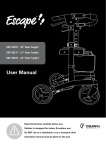Download SCD300 - Sound Storm Lab
Transcript
® L A B O R A T O R I E USER’S MANUAL S page SCD300 In-Dash CD Receiver Congratulations on your purchase of a Sound Storm Laboratories Receiver. It has been designed, engineered and manufactured to bring you the highest level of performance and quality, and will afford you years of listening pleasure. Thank you for making Sound Storm your choice for car audio entertainment! CONTENTS 2 Installation precautions 2 Before installation 3 Anti-theft installation 4 Inserting the front panel 4 Detaching the front panel 5 Removing the head unit 6 General and tuner controls 7 Audio controls 8 CD playback controls 9 Wiring diagram 10 Troubleshooting 11 Specifications SCD300 User’s Manual - page 1 Installation precautions Before installation Before installing your new Sound Storm CD Receiver, please become familiar with all the information contained in this manual. This CD receiver is shipped in the mounting sleeve. Choose a mounting location where the unit will not distract or otherwise interfere with the driver’s ability to control the vehicle. Before final installation, temporarily connect the wiring according to the diagram near the end of this manual, check it to ensure that it has been connected properly, and test the unit to make sure it is working correctly. Use only the installation parts and hardware provided with the unit to ensure proper installation. Using other parts can cause malfunction and possible damage to your Sound Storm CD receiver. Figure 1 Remove head unit from mounting sleeve For safety during shipping from the factory, the CD transport mechanism is secured within the sleeve by two screws, which must be removed before you can proceed with the intallation. See the diagram below regarding the placement of these screws and remove them. If installation requires drilling holes or other modifications to the vehicle, consult with your nearest dealer or professional car audio installer. Do not install this unit at an angle in excess of 30º from horizontal, as it may affect performance. Avoid installing the unit in a location which is subject to high temperatures, direct sunlight, hot air from such sources as heaters or exhaust lines, or where it will be subject to contact with dust, dirt, moisture or excessive vibration. Figure 2 Remove CD transport safety screws Figure 1 Bending the support tabs SCD300 User’s Manual - page 2 Anti-theft installation Insert the mounting case for the head unit into the dashboard. Inspect the dashboard material to determine its approximate thickness. Select the appropriate support tabs and bend them outward to secure the bracket in place using a screwdriver. (Figure 3) Before proceeding further, read the section of this manual entitled "System Wiring" and make all appropriate connections to the CD receiver, bringing the wires and cables through the rear surface of the mounting sleeve. After the mounting sleeve has been installed securely and all wiring connections have been made, slide the main unit into the mounting sleeve until fully seated and engaged (Figure 5). Figure 3 Select and bend the support tabs outward Bend the backstrap to conform to the mounting case and the dashboard surface to which you plan to secure the backstrap. Fasten it with the spring washer and nut provided. Using the screw and the plain washer provided, secure the backstrap to the dashboard surface as shown in the diagram. Tighten, secure, and check the overall mounting to be sure it is safe and will not release in an emergency stop or other sudden movement of the vehicle. Figure 5 Slide the head unit into the mounting sleeve. Snap the trim bezel in place. Figure 6 Snap trim bezel in place on front of head unit. mounting sleeve Figure 4 Attach the mounting sleeve with the backstrap. SCD300 User’s Manual - page 3 Inserting the front panel Detaching the front panel Insert the right side of the faceplate into the right side of the CD player chassis. Then puch the left side of the faceplate into the chassis until you hear a "click." (Figure 8) Press the RELEASE button to release the panel from the leftt side of the head unit (Figure 9). RELEASE button Figure 9 Press RELEASE to release the front panel Grasp the left side of the panel and pull to remove it (Figure 10). Figure 8 Push panel into main unit until you hear a “click” Figure 10 Grasp the left side of the panel and pull to remove the panel Immediately place the front panel in its protective case for safe and clean storage (Figure 11). Front Panel Be careful when handling the front panel! 1. Do not drop front panel. Figure 11 Place the front panel in its protective case 2. When detaching or reinstalling, do not put pressure on the display. 3. Do not touch the contacts on the panel or the main unit body – doing so may result in poor electrical contact. 4. Dirt or foreign substances can be removed with a clean, dry cloth. 5. Do not expose the panel to high temperaturees or direct sunlight. 6. Do not permit volatile agents or solvents to contact the front panel. 7. Do not attempt to disassemble the front panel. SCD300 User’s Manual - page 4 Removing the head unit Should you need to remove the head unit, first remove and store the front panel as described on the preceding page. Remove the front panel, then insert your fingers into the groove along the right side or the left side of the frame (not both!) and pull out to remove the trim bezel (Figure 12). Figure 12 Pull out to remove bezel Then, insert the levers supplied with the head unit into the slots on both sides of the unit as shown in the drawing until you feel a “click.” You can now use the levers to pull the unit from the dashboard (Figure 13). Figure 13 Insert levers until “click” occurs, then use levels to pull out head unit. SCD300 User’s Manual - page 5 General and Tuner Controls 1 2 8 7 General 6 5 Controls 1 RELEASE Press to release and remove the front panel. 2 CD SLOT 5 POWER Press to turn the receiver ON or OFF. 8 CLOCK DISPLAY AND SETTINGS Press this button once to display the current time. To set or reset time, press and hold this button until the time displayed begins flashing. The use the I<< and >>I buttons to change the displayed time. 4 Tu n e r 3 Controls 3 LOCAL/DISTANT SELECT Press to select between strong (LOC) and weak (DIST) stations. LOC mode will improve reception in some areas where the signals are too strong. DIST mode can improve reception in areas with weak radio signals. 4 MONO/STEREO SELECT The "ST" icon will appear on the display when there is a strong FM Stereo signal being received. The reception of more distant FM stations may be improved by switching to MONO mode by pressing this button. 6 BAND Pressing this button switches the receiver from AM to FM or vice versa. If you are currently in CD mode, this buttons changes the receiver to Radio mode. 7 TUNING KNOB Rotate this knob in Radio mode to select the desired station. The selected frequency will appear on the display. SCD300 User’s Manual - page 6 Audio Controls 1 2 3 5 Audio 4 Controls 1 EQ (Preset Equalizer Curves) Press repeatedly to cycle through three preset equalizer modes: POP, CLAS (Classical) or ROCK. 2 AUDIO FUNCTION SELECT/ADJUST Press the button repeatedly to access (in this order:) Volume, Bass, Treble, Balance and Fader functions. When you have selected a parameter to adjust (for example, Bass), use the VOL UP or VOL DOWN to adjust the level of bass. Adjust other parameters, in a similar manner. 3 VOLUME UP/DOWN BUTTONS Use these buttons to increase or decrease the volume level. These buttons also are used to increase or decrease the settings for Bass, Treble, Balance and Fader when you are in those modes. 4 LOUDNESS Press and release to increase the level of bass output. 5 MUTE Press to silence the receiver. Press again to return to normal operation. Please note that adjustments to Bass and Treble will override any preset EQ selections you have made. SCD300 User’s Manual - page 7 CD Playback Controls 1 6 CD Playback 5 Controls 1 EJECT Press to eject the disc. 2 REPEAT Press and release to repeat the same track. Press again to cancel the repeat function. 3 RANDOM Press to play ALL tracks on the CD in random order. 4 INTRO SCAN Press to play the first ten seconds of each track. To exit the intro scan mode, press again. Play will begin at the start of the track most recently played in intro scan mode. 5 PAUSE Press to pause CD playback. Press again to resume playback. If you are in Radio mode, pressing this button switches the unit to CD playback mode. 6 TRACK UP/DOWN BUTTONS Press and release to advance to the next track or to return to the beginning of the current track (track number will be displayed). Press and hold to fast forward or reverse. Play will begin at the point when you release the button. SCD300 User’s Manual - page 8 4 3 2 CD OPERATION TO PLAY A CD gently insert a CD with the label side up into the disc slot. It will automatically load and begin playing the first track. TO EJECT A CD press EJECT to stop the CD playback and eject the CD from the slot. The receiver will automatically switch to radio mode. TO PAUSE A CD press PAUSE to stop playback temporarily. Press again to resume playback. TO SKIP TRACKS press the I<< or >>I key to choose the next or preceding track. TO FAST FORWARD OR REVERSE press and hold the I<< or >>I key to access the desired location on the disc. Releasing the button starts playback at the location. TO REPEAT A TRACK press REPEAT to continuously repeat the current track. Press again to return to normal playback mode. TO PREVIEW ALL TRACKS press CD SCAN to play the first several seconds of each track. Press it again to play the current track being previewed. TO PLAY TRACKS IN RANDOM ORDER press and hold RDM for several seconds. Press again to cancel this function. Wiring diagram Follow the wiring illustration below closely to obtain proper performance from your CD receiver. Failure to make these connections properly may result in damage to your unit which will not be covered under your warranty. This receiver contains a built-in high power four-channel amplifier. To use the built-in amplifier, connect the speaker wires as shown. To use the receiver as a head unit in a mobile audio system which includes an amplifier, use the RCA outputs to connect to the front, rear and subwoofer inputs of your amplifier(s). Antenna connector Ignition switch (ACC +) RED Memory backup YELLOW (BATT +) 0.5A Fuse 7A Fuse to amplifier inputs, if present Ground (BATT -) BLACK RIGHT CH (RED) FRONT RCA OUT (BLACK) LEFT CH (WHITE) Power Antenna BLUE 0.5A Fuse RIGHT CH (RED) REAR RCA OUT (GREY) LEFT CH (WHITE) LEFT FRONT SPEAKER + – WHITE WHITE/BLACK LEFT REAR SPEAKER GREEN + GREEN/BLACK – RIGHT FRONT SPEAKER GREY GREY/BLACK RIGHT REAR SPEAKER VIOLET VIOLET/BLACK SCD300 User’s Manual - page 9 Troubleshooting If you experience operation or performance problems with this product, compare your installation with the electrical wiring diagram on the previous page. If problems persist, read the following troubleshooting tips which may help eliminate the problems. SYMPTOM No power. Disc cannot be loaded or ejected. No sound. Sound skips. Buttons on front panel do not operate. Radio does not work. SCD300 User’s Manual - page 10 CAUSE REMEDY The car ignition switch is not on. If the head unit is properly connected to the car accessory power circuits, but the engine is running, switch the ignition key to the “ACC” position. The fuse is blown. Replace the fuse. There is a disc already in the CD player. Remove disc in player and try again. Disc is inserted upside down. Insert the disc with the label facing up. Disc is dirty or defective. Clean the disc, or play a new one. Car interior temperature is too high. Allow temperature to cool down to a normal level. Excess atmospheric humidity or condensation is present. Leave player off for an hour or so, and then try again. Volume is set to minimum. Adjust volume to desired level. Wiring not properly connected. Check wiring connections. Head unit is installed at an angle of greater than 30º from horizontal. Adjust installation angle to less than 30º from horizontal. Disc is dirty or defective. Clean the disc, or play a new one. The built-in microprocessor is not operating properly due to noise. Remove and re-insert front panel. Front panel is not properly fixed in place. Remove and re-insert front panel. Antenna cable not connected. Insert the antenna cable firmly into connector. The signals are too weak to be received properly. Select station manually. ® Specifications L A B O R A T O R I E S SCD300 In-Dash CD Receiver CD PLAYER Signal-to-noise ratio Channel separation Frequency response RADIO FM Section: Frequency range IF Sensitivity (S/N = 30dB) AM Section: Frequency range Greater than 50 dB Greater than 50 dB 20Hz - 20kHz 88 - 108 MHz 10.7 MHz 10uV 530 - 1700 kHz AMPLIFIER Maximum output power 30 watts x 4 channels GENERAL Power supply req. Current consumption Chassis dimensions DC 12 volts, neg. ground 7 amperes maximum 7” x 6.2” x 2” (178 x 157 x 50 mm) All specifications subject to change without notice. SCD300 User’s Manual - page 11












